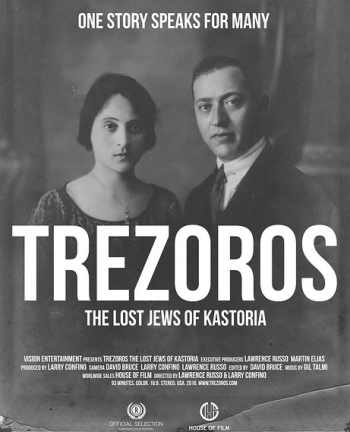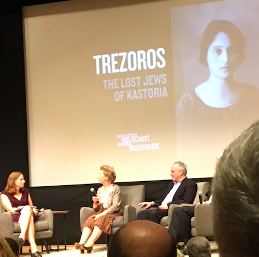
A film by Lawrence Russo and Larry Confino, 2016
Reviewed by Judith Roumani1
Viewed at the United States Holocaust Memorial Museum, June 23, 2017
The film was accompanied by a roundtable that included the two director-producers (descendants of survivors), Leslie Swift, the chief of the Film, Oral History and Recorded Sound Division of the museum, and Lena Russo (center, below), mother of Larry Russo and a survivor from the town of Kastoria, in northern Greece, where Jews and Christians had lived together for about two thousand years. A representative from the cultural attaché’s office of the Greek Embassy was also in attendance. Long before the Ladino/Judeo-Spanish-speaking Jews arrived with their own language five hundred years ago, there were already local Romaniote Jews in the area.

The ‘trezoros’ of the title seem to be the family members and neighbors of both faiths, Jews and Christians, who had been fast friends for decades. It might refer at the same time, without contradiction, to the present-day treasured memories that these people retain of their lives together in the town. The ninety-four-year-old Lena Russo described in lively terms how the two faiths had coexisted in harmony in this charming fishing port until the 1940s, when war came, first in the form of a benevolent occupation by the Italians, and then, after the Italians were ousted, a hostile one by the Nazis. Her return, so many decades later, to visit the town and her old friends and neighbors is the highlight of the film.
In March 1944 black snow fell on the town, and was seen as an evil omen. It was actually fallout from an eruption of Vesuvius which had happened a few days before and sent its dust far and wide. Immediately after that, the Nazis arrested all the Jews, the cries of separated family members being heard all over the town. Of 900 or so Jews, only 35 would eventually come back. As the Jews were being shipped to extermination camps, that very afternoon the Nazis announced that all the Jewish property in the town had been expropriated.
Some of the few survivors, from the Russo and Confino families at least, ended up in America. The film is a story told by its survivors, with interviews filmed on location in Kastoria, Thessaloniki, Athens, Tzur Moshe, Tel Aviv, Miami, and New York. The decision to make this evocative film about Lena’s return led to much documentary research, painstaking interviews with Jews and Christians, revival of old family movies,2 and lovely footage of an entrancing area whose beauty should never have been sullied by such evil.
1 Judith Roumani is the editor of Sephardic Horizons, and co-editor, with Jacques Roumani z”l and David Meghnagi, of the forthcoming Jewish Libya: Memory and Identity in Text and Image (Syracuse: Syracuse University Press, 2018).
2 This documentary film used never-before-seen archival footage that is now in the Holocaust Museum’s collection.
